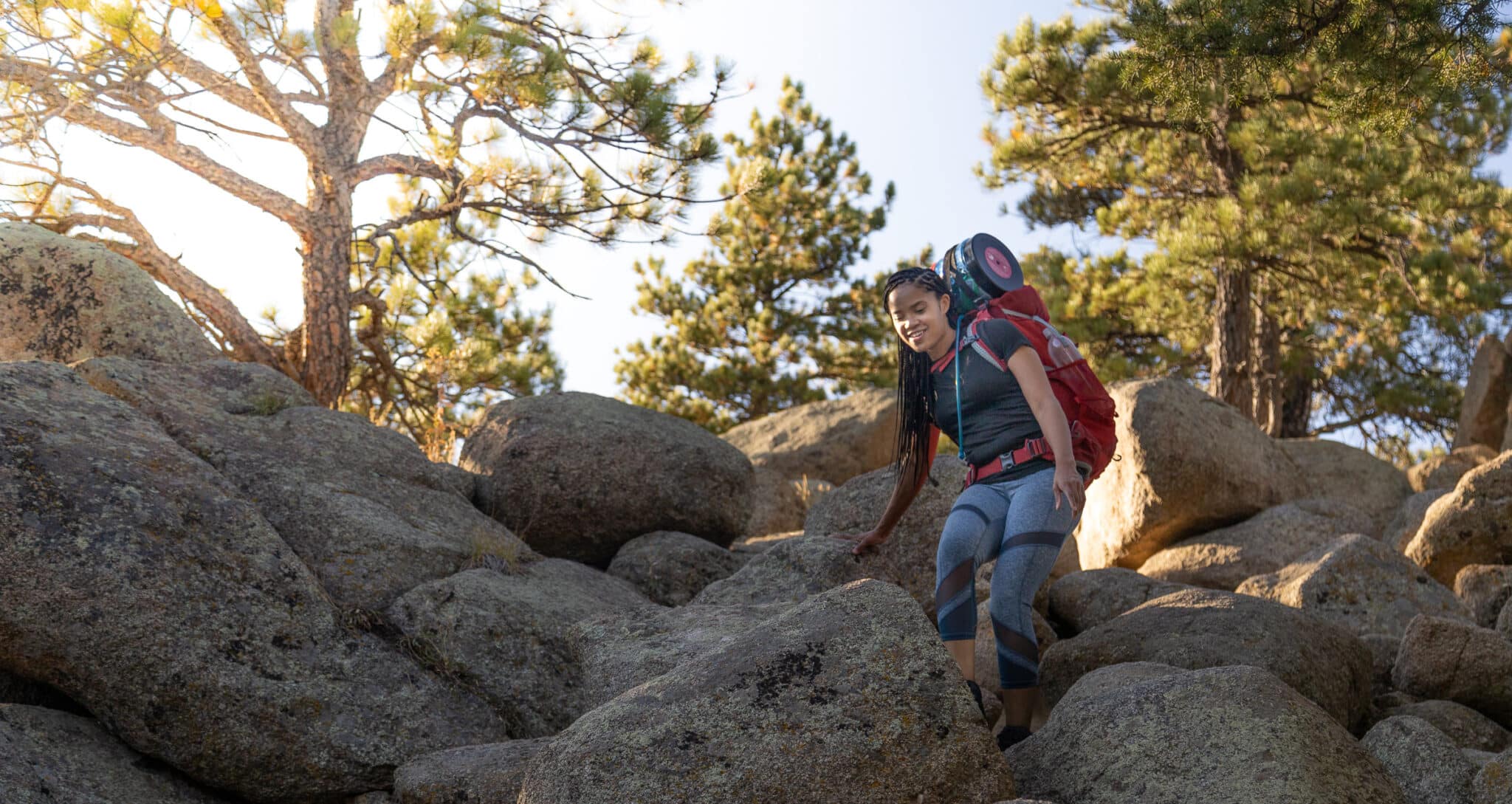For most menstruating people, periods can be somewhat of a nuisance. It requires a bit of extra planning ahead and if your cycle isn’t regular, you can sometimes get hit with a surprise appearance. This can be especially annoying when you’re in the backcountry and are hiking on your period.
The popular Scout motto, “Always be prepared,” may be what you live by as an outdoor enthusiast, but if you’re a hardcore ultralight backpacker, carrying extra weight goes against everything you stand for. Luckily there is a way to bridge that gap regardless of which camp you sit in. But first, we need to debunk a common period myth.
Can bears “smell the menstruation”?
The 2004 hit Anchorman starring Will Ferrell and Steve Carell might not have given birth to this misconception, but it likely perpetuated it. Carell’s character, Brick Tamland, is quoted saying, “I read somewhere their periods attract bears. Bears can smell the menstruation.” Is this statement true? The short answer is no. But let’s dive a little deeper.

Bruce Cushing, a Bear Management Biologist, wrote a paper discussing the topic of bears and menstruating women. A study was conducted in 1983 with captive polar bears to test the hypothesis that bears are attracted to menstrual odors. The study included seal scents, other food scents, non-menstrual human blood, and used tampons. When presented with this series of odors, the polar bears elicited a strong behavioral response to only the seal scents and used tampons. It was also reported that free-ranging polar bears detected and consumed food scent samples and used tampons but ignored non-menstrual human blood and unused tampons.
In 1985 the circumstances of dozens of grizzly bear attacks on humans in Yellowstone National Park were analyzed, including attacks on two women in Glacier National Park. The conclusion was that no evidence linking menstruation to any of the attacks was found. It should be noted that the responses of grizzly bears to menstrual odors have not been studied experimentally.
Responses of 26 free-ranging black bears to used tampons from 26 women and 20 free-ranging black bears to four menstruating women at different days of their flow were recorded in 1991. It was found that menstrual odors were essentially ignored by black bears of all sex and age classes. No instances of black bears attacking or being attracted to menstruating women were found when an extensive review of black bears across North America was conducted.
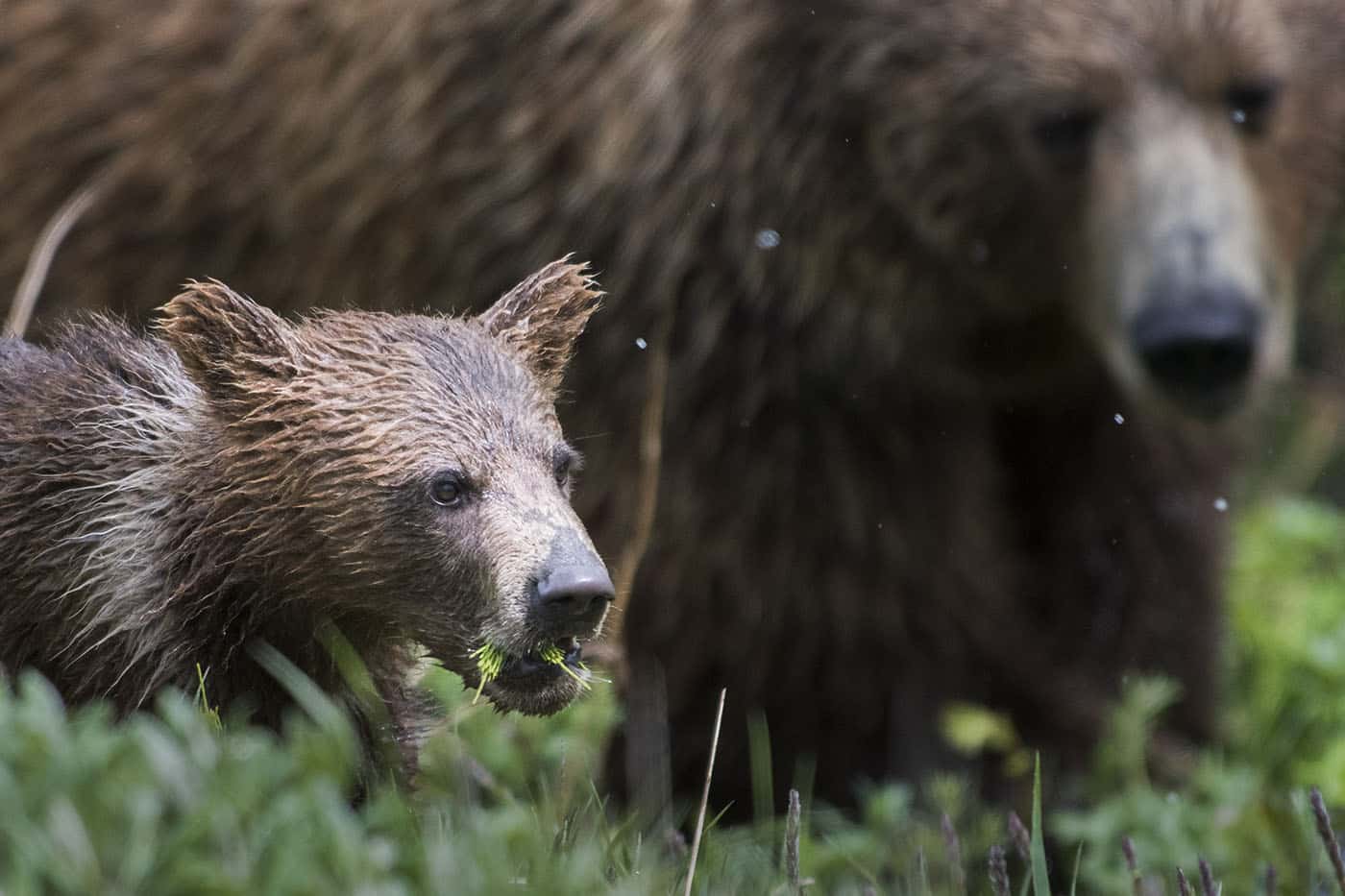
So, if you’re walking through the woods on your period, it’s unlikely a bear will sniff you out and attack you. In fact, the only bear remotely attracted to menstrual blood was polar bears and that was in the instance of being presented with a used tampon.
Unless you’re taking a backpacking trip in polar bear country and planning to bury or toss your used menstrual products on the ground, you shouldn’t have anything to worry about. If your collection preference is disposable, you’ll need to pack out what you pack in and treat it as you would any other piece of garbage.
Leave No Trace compliant menstrual products
It is a great time to be alive and have a period. Why? Options. A mere 20 years ago when I started my period, the myriad of options that exist today, were not available. I was presented with two options for collection, pads or tampons. Neither of which is what I use today.
It is a great time to be alive and have a period.
-Rachel Strysick
If you’re a thru-hiker, it’s likely you’ll need a bear-resistant canister for all or at least a section of the trail you’re hiking. This is where you’ll store your used tampons and pads with your other trash items. Some prefer to have a separate trash bag for these items, while others will simply lump them in with their other trash. It’s a matter of personal preference. As long as you’re not burying or leaving the used product behind, you can choose whichever suits you.
If you prefer a menstrual disc or cup, you’ll need to store it in your bear canister when it’s not in use. These are a great option for ultralight backpackers as they’re reusable and lightweight, and you only need to bring one. In addition, there are so many on the market today, you’re sure to find the perfect fit for yourself.
You’ll need to boil the disc or cup for five minutes before you use it. For some, this may seem gross, using the same pot you cook in to boil your product. If that’s you, you can bring an extra pot solely for this purpose, but it’s not necessary since you’re sterilizing it with boiling water. You may choose to wash the pot after boiling the product before you cook your food, or you can simply dispose of the wastewater and boil fresh water in the pot to sterilize it again. Always dispose of wastewater 200ft from any water source.
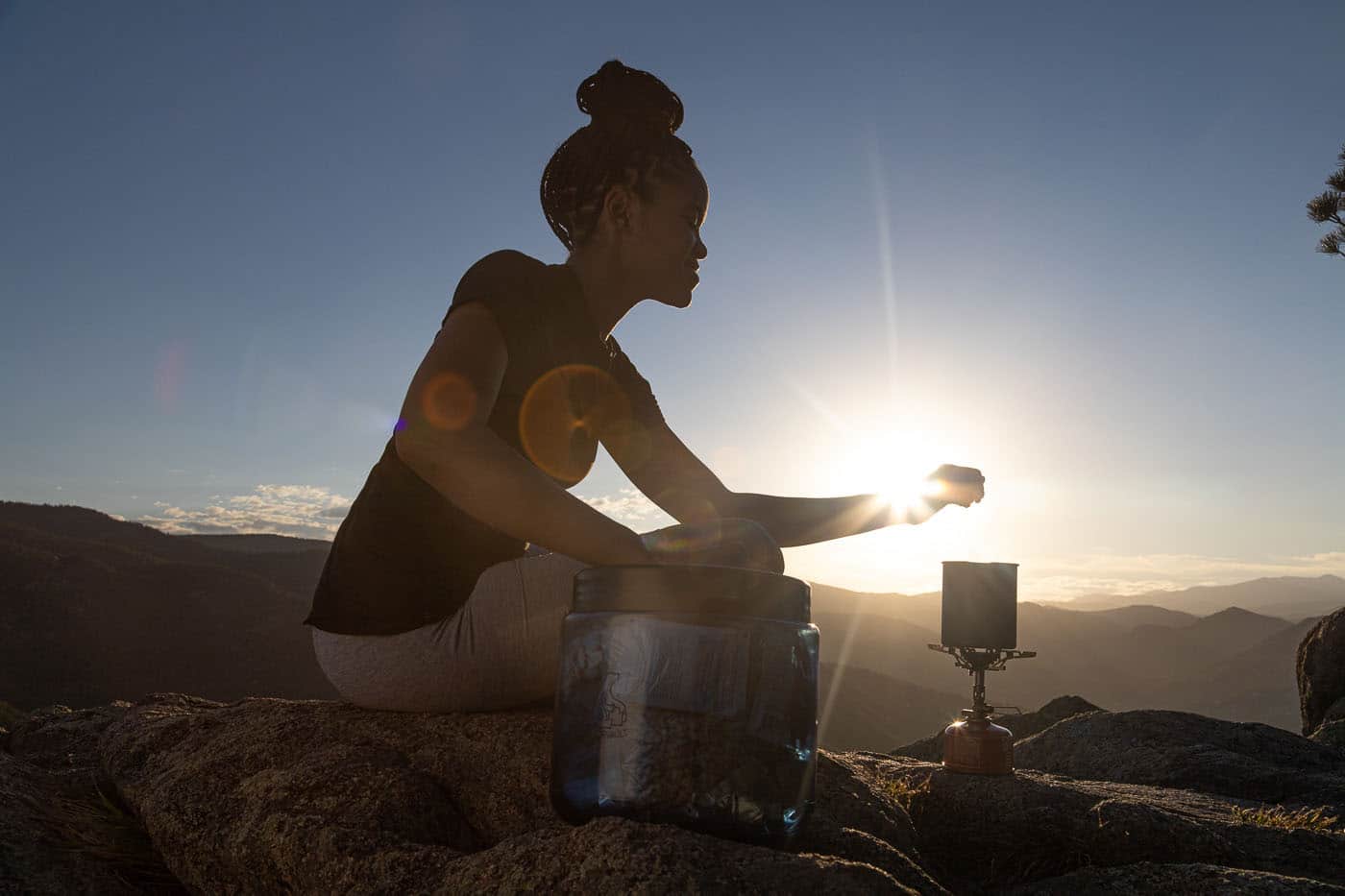
One thing you’ll need to keep in mind when using a cup or disc is the disposal of its contents. You should treat this bodily fluid the same as you would defecation. You’ll dig your six-inch cathole and dump the contents before burying it. Never dump menstrual blood directly on the ground or in water sources. If you’re lucky enough to encounter a toilet, you can always dump it there. After dumping the contents, you’ll want to clean your cup or disc. Most companies that sell these products offer cleansing wipes for this purpose, or you can rinse them with water before reinserting them. If you use the wipes, these will need to go in with your trash after being used.
Another popular option for long-distance hikers is using a birth control method to stop periods altogether. You’ll need to discuss this with your healthcare provider to find out which option is best for you. It should be noted that sometimes these methods are not 100% effective, and you’ll have breakthrough bleeds, so you’ll need to have some collection method with you in the event that happens. If you aren’t currently using birth control, it might be a good idea to start it several months before your trip to make sure it’s the right fit for you.
Proper menstrual hygiene in the backcountry
Probably one of the most important aspects of menstruating while in the backcountry is hygiene. The bacteria that populate the vagina are extremely important to keep in balance. When out of balance, it can lead to yeast infections, trichomoniasis, and bacterial vaginosis. These conditions often require diagnosis by a medical professional and treatment in the form of antibiotics or antifungal medication. If you’re in an area that isn’t close to civilization, this can mean having to deal with the symptoms without proper treatment for an extended period of time.
If your collection method requires the insertion of a product that includes your fingers, it’s imperative that you ensure they’re as clean as possible before you do so. I personally use Dr. Bronner’s Pure-Castile Soap because it’s biodegradable, non-toxic, and concentrated, so a little goes a long way. You should be at least 200ft from water sources when using any biodegradable soap as it can still contaminate the water source. If you’re looking for an ultralight option, you can grab powdered soap as it will weigh far less than liquid soap. All soaps should be stored in your bear-proof food container as anything with a scent is deemed food to the nose of a bear.
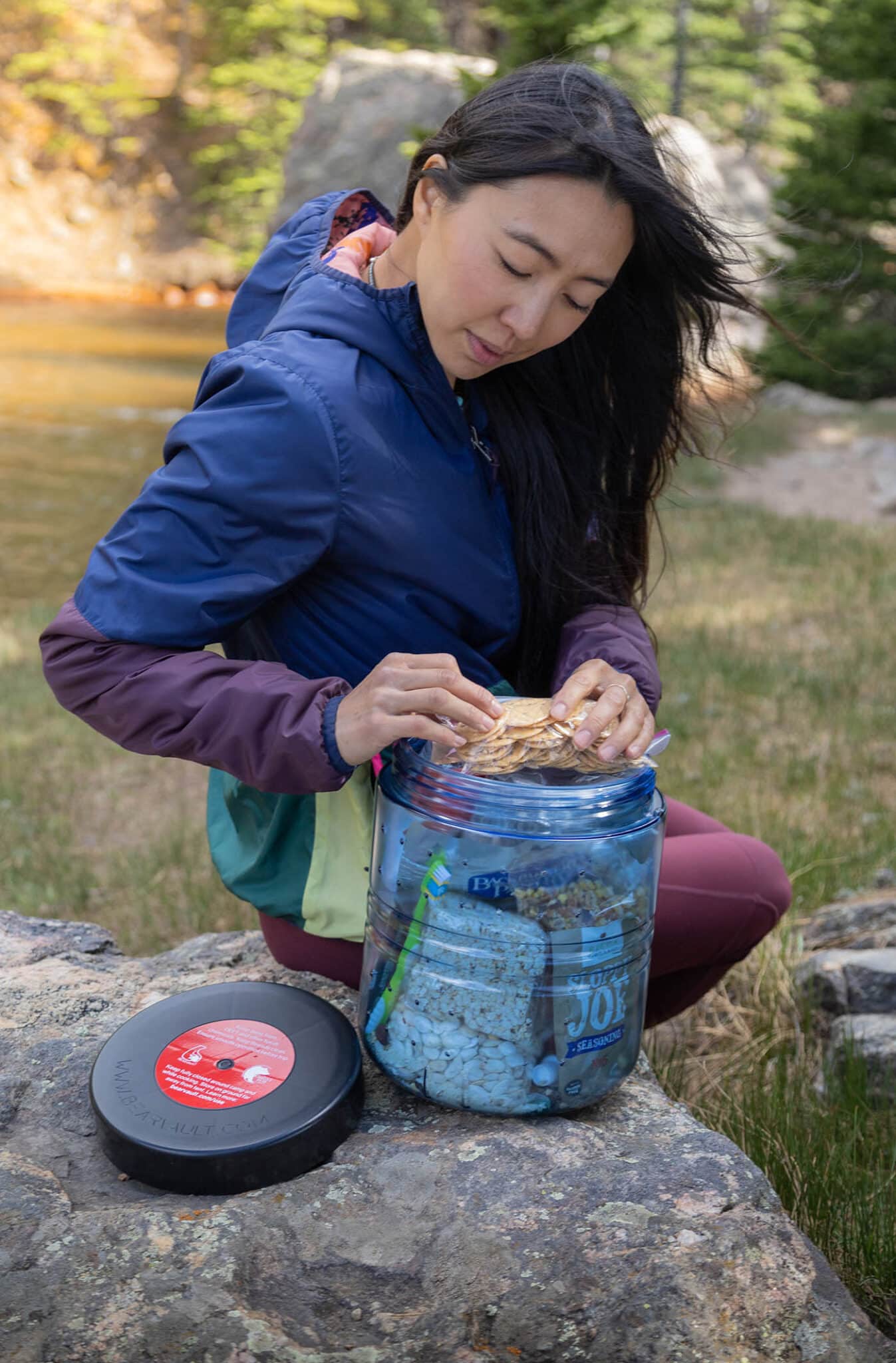
Another key piece of gear that I always bring with me is a probiotic. These are not only essential for vaginal health but also for gut health. The wonderful thing is that they come in a multitude of options. You can opt for a capsule that doesn’t require refrigeration, a snack bar that includes a probiotic, or even a powdered form of kombucha. The kombucha option is a fun one because it’s an opportunity to drink something other than water. Make sure your probiotic includes Lactobacillus Acidophilus and Lactobacillus Plantarum as they’ve been shown to reduce rates of bacterial vaginosis and yeast infections.
If you have cramps while hiking on your period
While not a technical aspect of hiking with your period, having pain while menstruating can be a major inhibitor for those who deal with it. Luckily, the options for dealing with this are equally as numerous as the collection methods.
If you speak to your healthcare professional about this issue you are sure to be presented with two options, birth control or non-steroidal anti-inflammatory drugs (NSAIDs). Both are valid options if you deem them right for you. More importantly, though, you need to have experience with them to know that they will be effective at mitigating your pain.
If you choose a more holistic route for yourself, there are several companies that specialize in creating products specific to tackling period pain. Most include certain vitamins, minerals, or plant compounds, such as turmeric, which help with both pain and inflammation. Some menstruators find relief through a method called seed cycling.
Seed cycling is the practice of supporting your hormones through the ingestion of specific nuts and seeds during the specific phases of the menstrual cycle. For the first 14 days, you consume one to two tablespoons of pumpkin and flax seeds—it’s key that the flax seeds are ground for better nutrient absorption—to support estrogen production. For days 15-28, you consume one to two tablespoons of sunflower and sesame seeds to support progesterone production. You can easily add these to your meals or pick snack bars or meals that already have these nuts and seeds in them.
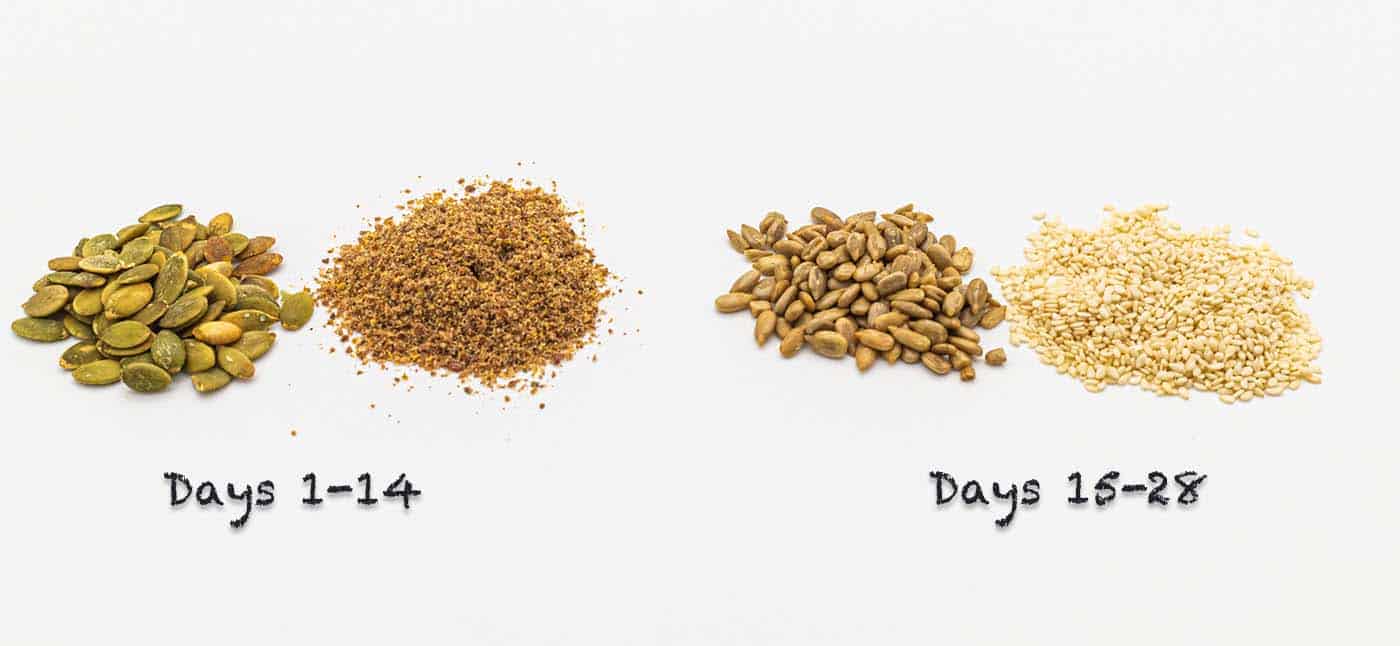
Another option for a holistic remedy is CBD. CBD comes in multiple forms, tinctures, edibles, topical creams, etc., and is used for pain and inflammation. Regardless of the form you choose, it’s likely it will have a scent, so it will need to be properly stored in a bear-proof canister to keep wildlife safe while hiking on your period.
In a study of Appalachian Trail thru-hikers, 41% experienced shortened periods and 22% experienced amenorrhea.
If you’re a long-distance hiker, that may be a remedy in itself. Many long-distance hikers who have periods report that their cramps greatly decreased, or their periods vanished altogether due to the vast increase in physical activity. In a study of Appalachian Trail thru-hikers, 41% experienced shortened periods and 22% experienced amenorrhea. This phenomenon should not be viewed as a foolproof solution for all as some menstruators will still get their periods regardless and it is not guaranteed that your pain will decrease. You should always have both a collection method and a pain reliever on hand just in case.
Protecting yourself and the wildlife who call the backcountry home
Whether you decide to walk into the wild with your period or schedule your trip around it, you should always be thinking of the creatures who call that environment home. The best way you can do this is by bringing a bear-proof food container with you. It only weighs a few pounds, and it ensures that wildlife cannot access food or food-like substances. This helps keep them wild, alive, and free to roam the area they’ve lived in all their lives. A small investment from you means a direct investment in the conservation of our beautiful national parks, forests, and ecosystems.

